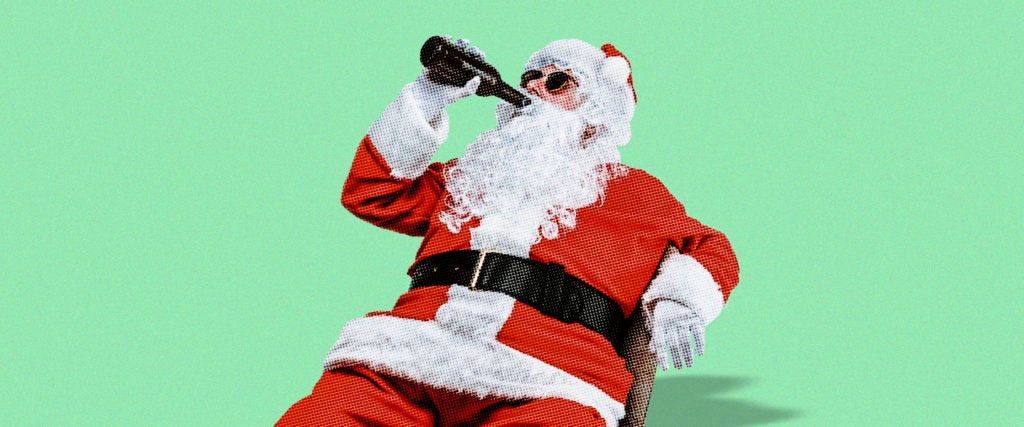It’s the most wonderful time for a beer, goes the song, and Christmas wouldn’t be Christmas without fairly solid drinking all day long, from your cheeky breakfast mimosa to the jolly afternoon eggnog to the can of room-temperature Coors you drink angrily on your own in your bedroom after an enormous argument with everyone who loves you.
It’s easy to go wrong, though — it’s one of the few days of the year when it’s basically socially acceptable to have a can while cleaning up after breakfast, and that not even be your first drink of the day. Combine this early start with industrial amounts of food — while Christmas dinner varies from culture to culture, it tends to come by the shitload — and you can easily lose consciousness by mid-afternoon, drooling on a half-unwrapped gift in front of your horrified relatives. Plus at the height of winter, are endless ice-cold brewskis really what you’re after?
“In winter, I can think of nothing better than sitting in front of the fire sipping on a fine dark beer,” says Nick Thompson, purchasing manager at Beer Hawk. “Styles such as stouts, porters and Belgian ales tend to be big on flavor, big on mouthfeel and big on the ABV. These beers are to be sipped, not gulped, and so taste that little bit warmer than lighter beers like lager — perfect to keep you warm on the coldest of nights. That said, I know Christmas for some people is all about overindulging. If your traditional Christmas meal is a seven-course feast, you may want to stick to more sessionable beers. You can now get session beers in most styles — they may be lower in ABV but you don’t lose any of the flavors and they can be highly drinkable.”
The difference between stouts and porters is, to most drinkers, fairly negligible — they’re both dark and heavy and tend to be strong in terms of flavor and alcohol. “Ask three beer experts to tell you the difference and you’ll get three different answers,” says Pete Brown, beer enthusiast and Chair of the British Guild of Beer Writers. “There are also old ales and barley wines, which tend to be about 8 percent or 9 percent alcohol. Think about where the fermentable sugar comes from — it’s grapes with wine, and with beer it’s malted barley. If you want to get a beer to that kind of strength, you’ve got to put a lot more malted barley in than if you’re producing 4 percent beer. And some of these grains will have been roasted, which makes them darker and the flavors richer, just as with coffee.”
Spending an entire day drinking thick stout is incredibly difficult, as one or two glasses can leave you feeling like you just won a pie-eating contest, so Brown advises starting on something lighter. “A lot of beer aficionados will kick off the day with a favorite lambic or Belgian-style gueuze. They’re known as sour beers, which annoys me because you wouldn’t call an acidic white wine sour, you’d say it was crisp or sharp or something.”
“I’ll have something light and pale when I’m cooking Christmas dinner. Last year I had some bottles of Pliny the Elder, an IPA made by Russian River Brewing in California, and had one of those to keep me topped up while sweating in the kitchen and it was perfect. Next, it’s onto the Belgians for dinner, and then, what I love is when you’re totally full and beached on the sofa, sipping away on something strong, rich and sticky. That’ll be a reward for being on my feet cooking for hours, a beer I’ve saved for Christmas. I’ll really take my time over it, maybe drink it out of a brandy balloon or something.”
If there’s one beer that is the default in your house — where it’s reached the point that it’s just “a beer,” and doesn’t even have a proper name anymore — a celebration like Christmas seems the perfect time to mix it up. You wouldn’t wear a sweater with a big stupid robin on it any other day of the year, so why drink the same beers that inhabit your fridge all year round?
“Even if you aren’t as crazy about beer as me, there are bottle shops everywhere now. Go in and ask them what they’d recommend,” says Brown. “You might end up with something where you go, ‘Bloody hell, this is how much?’ But, well, yeah — that’ll have had as much care and energy and devotion and skill put into it as a bottle of wine that costs the same. With my main course, I’m serving a beer called Deus, which is brewed with Champagne yeast and costs about $20 a bottle, in Champagne flutes. I’d imagine that people who drink prosecco all the time don’t drink the same stuff on Christmas — they probably get a slightly nicer bottle. So it’s the same principle really.”
Don’t be a Scrooge when it comes to festive drinking (Scrooge’s first name, Ebenezer, contains all the letters of “beer,” by the way). Christmas comes once a year, and a couple of well-chosen indulgent beers will stick in your memory far longer, and make the whole thing feel more like a special occasion, than just necking a few of the usual. Lots and lots of well-chosen indulgent beers? Even better. Santa Claus wasn’t crucified so you could throw up a bunch of fucking Bud Light. God bless us, every one!

